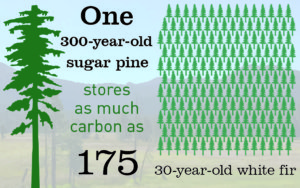
Summer 2018 ForestLife
Pioneering progress on forest and climate policy
Update 12/17/18: Forest Health and Fire Policy Highlights from 2018
California is implementing a pioneering economy-wide climate policy, but its ambitious climate goals require thoughtful planning to yield enduring benefits. The state recognizes the power of natural system’s sequestration to meet its goals, especially through restoring and managing for climate resilient, carbon rich forests. Forests are among the most effective and cost-effective climate solutions; indeed, while climate investments in forests were roughly 3% of those the state had made by 2018, they accounted for 14% of the reductions goal. Well-designed forest climate projects help sustainable wood, water, and wildlife, too. PFT has been a leader in California’s forest climate policy from its very beginning, and we’re now focused on expanding California’s natural and working lands climate change policy portfolio to better realize this state’s natural potential to mitigate and adapt to climate change.
How healthy are California’s forests?

Managing for older trees and forests is a key strategy for climate. Source: Stephenson, N.L., et al. (2014), Nature, “Rate of tree carbon accumulation increases continuously with tree size.”
The California Legislative Analyst’s Office (LAO), a non-partisan fiscal and policy research agency, recently released a wide-ranging and well-researched report on “Improving California’s Forest and Watershed Management.” The report details the many values of forests and their currently degraded conditions in California; it concludes that current levels of funding and coordination are not adequately addressing forest conditions and, in fact, that certain state policies and practices have inhibited activities that improve forest health, especially those concerning fire suppression and prescribed/managed fire. It also found that those who benefit from forests’ contributions to clean water don’t contribute much in the way of funding activities that make forests healthier (read the report here). These findings are consistent with PFT’s findings and experience.
What is California doing about it?
The good news is that California’s effort to prepare for our changing climate by restoring more natural and resilient conditions is picking up momentum. In the first half of 2018 alone, Governor Jerry Brown released the Forest Carbon Plan, convened a new interagency Forest Management Task Force, and signed a budget with over $210 million in forest investments—something PFT strongly advocated for. He also issued an executive order that calls for improved forest management, regulatory improvements for small landowners, and reduced barriers to the use of prescribed fire.

Trees’ ability to store carbon is one reason forests are such an important and cost-effective climate solution. Note the fire scars; old trees, such as this coastal redwood, are particularly resilient to fire.
The newly-released Forest Carbon Plan provides direction on how forests can specifically help meet California’s climate goals. PFT is pleased that many of our recommendations, as well as a case study, were included in the Plan (read it at pacificforest.org/fcp). Those recommendations highlight managing for climate resilient outcomes, with a focus on restoring natural forest functions, linking restoration with conservation to ensure long-term climate benefits, and carefully restoring more natural fire regimes to the landscape to maintain healthy forests. Our case study is on the Black Butte project, which has now been awarded over $5 million from the CAL FIRE Forest Health Program. It demonstrates how integrating management with conservation easements secures investments in restoration and resilient management for future generations, also yielding immediate benefits.
In addition to the Forest Carbon Plan, the state’s climate policy is influenced by state goals for adaptation (in the Safeguarding California plan) and the Air Resources Board’s Natural and Working Lands Climate Change Implementation Plan. PFT’s goal is to ensure these multiple plans come together in thoughtful, integrated, and targeted policies; climate-smart investments; and enduring benefits. We also work with landowners to design on-the-ground projects that accomplish these goals by combining emission reductions, improvements to forest and watershed health, and climate adaptation, in order to restore resilience to the landscape in our changing climate.
Updated 12/17/18: Here are some highlights of changes to California’s forest health and fire policy from 2018.
- A commitment to spend $200 million annually for the next five years on forest health and fire prevention projects. This includes:
-
- $165M for the Forest Health, Forest Legacy and Fire Prevention programs, and
- $35M to continue CalFire’s Rx fire program.
- An expansion of the forest thinning exemption that expedites thinning projects subject to numerous conditions, including practicing selection forestry, increasing the quadratic mean diameter (average size of the trees), and requirements to reduce surface and ladder fuels to manage fire behavior. The change increased the maximum size of tree that can be harvested from 26” at the stump to 30” at the stump. It also allows short lengths of temporary road to be built, subject to limits on slope, unstable areas, and stream crossings. We are now working at the BoF to establish a good monitoring and reporting system.
- A new requirement that state-funded WFCEs include provisions “to maintain and improve forest health through promotion of a more natural tree density, species composition, structure, and habitat function, to make improvements that increase the land’s ability to provide resilient, long-term carbon sequestration and net carbon stores as well as watershed functions, to provide for the retention of larger trees and a natural range of age classes, and to ensure the growth and retention of these larger trees over time.”
- New requirements for the Air Resources Board (ARB) to develop a historic baseline of greenhouse gas emissions from wildfire, reflecting conditions from before fire suppression.
- A new requirement that ARB report on the GHG emissions of both wildfire and forest management activities every five years.
- A new Wildfire Resilience Program at CAL FIRE to assist small landowners with permitting and grant applications for vegetation management.
- Requirements for new defensible space requirements in Very High fire hazard areas.
- Clarification that both NTMPs and Working Forest Management Plans (WFMP) can cover multiple landowners. The WFMP (created by PFT Board Member and former state legislator Wes Chesbro) had been subject to litigation on this issue.
- Streamlining the ability to spend state funds on federal land, by waiving the need to do a California Environmental Quality Act analysis if NEPA has already been done for the project.
- Making more forest biomass material eligible for an existing biomass incentive program, essentially relaxing the geographic limitations.
- Allow CAL FIRE to make advance payments for most grant programs.
Workforce Training
- Requires the California Conservation Corps to establish four forestry corps crews to train and educate corps members in forestry. Requires forestry corps members to develop and implement forest health projects.
Prescribed Burning
- Declares that compliance with a CAL FIRE burn permit constitutes prima facie evidence of due diligence.
- Authorizes CAL FIRE to engage in cooperative burning and requires CAL FIRE to hold harmless, purchase insurance for, or limit the liability of partners it is contracting with for cooperative burning.
- Requires CAL FIRE and ARB to develop a program to enhance air quality and smoke monitoring, and to provide a public awareness campaign regarding prescribed burns. Authorizes the program to include purchasing new, rapidly deployable air quality monitors. Also provided funding for these activities in the budget.
Your support for Pacific Forest Trust helps ensure that carbon rich, climate resilient forests are a working—and growing—component of climate policy in California and beyond.
More in this Issue of ForestLife
- President’s Letter
- Restoring carbon rich, climate resilient forests across the west coast
- A first for Oregon: Mountcrest Forest conserved
- What price a watershed?
- Donor Profile: Andrea Tuttle, PhD
- Saving beavers, headwaters, and tall timbers at McCloud Soda Springs
- Forestry at Soda Springs: Back to the future
- A fabulous Forest Fete!
